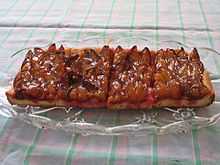Zwetschgenkuchen
| Zwetschkenkuchen | |
|---|---|
|
A piece of Zwetschkenkuchen | |
| Alternative names | Quetschekuche, Zwetschkendatschi, Prummetaat |
| Type | Sheet cake or fruit pie |
| Main ingredients | Yeast dough or shortcrust, prune plums |
|
| |
Zwetschkenkuchen or Pflaumenkuchen is a sheet cake or pie made from yeast dough or shortcrust dough that is thinly spread onto a baking sheet and covered with pitted zwetschgen. It is popular as a summer cake and has different local labelings throughout Germany, Austria and Switzerland.

In Hessen, Rhineland-Palatinate, Saarland and Moselle it is known as Quetschekuche, in Bavaria, Baden-Württemberg and parts of Austria it is called Zwetschkendatschi and in Rhineland and the Eifel Prummetaat. "Datschi" is thought to be derived from the dialect word "detschen" or "datschen" that can be translated as "pinching" (as the plums are pinched into the dough). Although it is common to serve it with Streusel (a crumbly mixture of butter, sugar and flour) the original recipe serves it plain without any toppings.
The people from Augsburg claim to have invented the cake. It is considered the city's signature dish and according to the original recipe it is made with shortcrust pastry. Due to this dish the City is nicknamed "Datschiburg" and it is said that the look resembles the city's coat of arms, the "Zirbelnuss".
In the Palatinate and Rhenish Hesse it is eaten with potato soup or vegetable soup as a main dish for lunch. In contrast the people in Saarland eat it with bean soup and call this dish "Bibbelschesbohnesup un Quetschekuche".
See also
- German cuisine
- Austrian cuisine
- Cake
- List of German desserts
- Food portal
